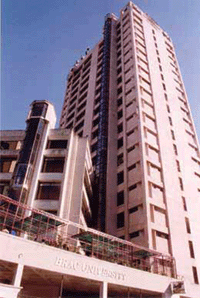 What one needs for creating Technology Based Higher Education (TBHE) -environment in Higher Educational Institutions (HEI) are necessary logistics like multimedia projectors, computers, Internet connectivity with necessary bandwidth, skilled e-content development group, technology-friendly HEI administration, adaptability of the learners to TBHE environment, etc. In Bangladesh, many of these conditions do not persist at a satisfactory level. Besides, it is difficult for a particular HEI to incorporate all of them. Feeling the requirement of an implementation-friendly framework for TBHE, the authors propose a framework for promoting TBHE-environment in HEIs of Bangladesh, perhaps suitable for other developing nations also. The methodology of the framework was incepted from the National ICT Policy of Bangladesh and the feedback of the expert-group working on ICT and Higher Education in Bangladesh. For this, the authors used the data of the survey conducted by the Expert Group responsible for preparing report on “Strategic Planning for ICT in Higher Education”, of which one of the authors is an expert member. The TBHE-environment for dissemination of information in limited form in most of the public universities in Bangladesh. However, a few private universities are promoting TBHE-environment exists for authentic delivery of learning-contents in electronic form through web and other media. The authors studied their approaches and compared it with the proposed framework.
What one needs for creating Technology Based Higher Education (TBHE) -environment in Higher Educational Institutions (HEI) are necessary logistics like multimedia projectors, computers, Internet connectivity with necessary bandwidth, skilled e-content development group, technology-friendly HEI administration, adaptability of the learners to TBHE environment, etc. In Bangladesh, many of these conditions do not persist at a satisfactory level. Besides, it is difficult for a particular HEI to incorporate all of them. Feeling the requirement of an implementation-friendly framework for TBHE, the authors propose a framework for promoting TBHE-environment in HEIs of Bangladesh, perhaps suitable for other developing nations also. The methodology of the framework was incepted from the National ICT Policy of Bangladesh and the feedback of the expert-group working on ICT and Higher Education in Bangladesh. For this, the authors used the data of the survey conducted by the Expert Group responsible for preparing report on “Strategic Planning for ICT in Higher Education”, of which one of the authors is an expert member. The TBHE-environment for dissemination of information in limited form in most of the public universities in Bangladesh. However, a few private universities are promoting TBHE-environment exists for authentic delivery of learning-contents in electronic form through web and other media. The authors studied their approaches and compared it with the proposed framework.
Educational institutes, particularly the Higher Education Institutions, are the largest stakeholders to adapt to the technological advancement for better and efficient rendering of education to the mass learning community including regular classroom based as well as distant student via online and offline e-Learning. Though in recent years, HEIs in Bangladesh are using ICT in learning and teaching processes in order to increase the quality, efficiency, and dissemination of education, but not many of them could siege the opportunity and leverage significant benefits by adapting themselves to Technology based Higher education environment.
Current status of TBHE in Bangladesh
Status of public sector HEIs
Most of the public sector HEIs did not adopt technology for the improvement of imparting quality education. The major technology medicated activities performed by them are typical in nature that includes: uses of web sites for disseminating general information to the visitors, whereas no learning contents are disseminated; content delivery using overhead and multimedia projectors.
Status of private sector HEIs
Most of the private sector HEIs represent the similar scenario like public sector HEIs. However, few selected HEIs are more aware about the necessity of TBHE environment and striving to provide more technology mediated services to their students. They have their own units of content development activities under different names and responsibilities. The TBHE support provided to their students are: authentic access to course material within and outside the campus, online submission of assignments and term papers, access of online transcript to the student and respective advisor, using log to monitor online activities of students, online discussion forum, providing digital library (own and professional like IEEExplore, ACM digital library), etc.
Usage of TBHE in distance education
In Bangladesh, the only public sector university offering distance education is the Bangladesh Open University (BOU). Facilities provided are: maintaining website; established Media Center responsible for content development (CD based; non-interactive) for secondary, higher secondary and postgraduate courses; broadcasting recorded lectures through television and radio; etc. Learners still need to go to the tutoring/resource centers to give examination. Integration of remote and virtual lab is totally absent and the relevant lab courses are seldom conducted.
Usage of TBHE environment in research and development
In most of the countries such as India, Pakistan, England etc. there exist special ICT facilities to extend helps to people engaged in research and development activities in its HEIs. There is one such network infrastructure in Bangladesh in the name BERNET (Bangladesh Education and Research NETwork: www.ugc.org/bernet.htm). This is the monitoring unit, which provides a quality assurance role to JISC (Joint Information Systems Committee) in monitoring its network infrastructure and network content services to the researchers in different HEIs.
Status of TBHE friendly administration
Though the University Grants Commission (UGC) of Bangladesh regulates and approves the syllabuses of the private sector HEIs, there exists no monitoring body to oversee the separate ICT unit, if any, within the HEIs. Most of the public sector HEIs have independent ICT divisions doing typical ICT chores such as proper functioning of email, etc. However, they do not provide technology-supportive quality education due to the lack of TBHE friendly administration, policy framework and skilled human resources.
Necessity of TBHE framework
 Within an HEI, the successful establishment of TBHE environment largely depends not only on the friendly administration and fund, but also on an approved framework. The framework helps in streamlining the quality of education, research and other services provided by various HEIs and eventually increases their competitiveness. Based on the learners’ needs (regular or distant), the framework helps the HEIs in designing their learning system, which is crucial for the development of the TBHE environment. Development of massive and costly system May not be useful due to socio-economic and cultural background of the learners. The framework can help HEIs in this regard.
Within an HEI, the successful establishment of TBHE environment largely depends not only on the friendly administration and fund, but also on an approved framework. The framework helps in streamlining the quality of education, research and other services provided by various HEIs and eventually increases their competitiveness. Based on the learners’ needs (regular or distant), the framework helps the HEIs in designing their learning system, which is crucial for the development of the TBHE environment. Development of massive and costly system May not be useful due to socio-economic and cultural background of the learners. The framework can help HEIs in this regard.
Components of the proposed TBHE Framework
Establishment of content development centers
As acquired material (books, periodicals, journals, off-the-shelf educational software, etc) does not meet all the needs of an HEI, it is necessary to establish its own CDC. While establishing a CDC, the following issues need to be taken care of, such as: using cutting-edge technology, creative design modules for course content development as well as assessment through online exam, and seamless implementation of services and its maintenance.

Adaptive standard of disseminating learning content
The most commonly used mechanisms for the dissemination of course material and other resources are email, shared-folder through intranet, Internet, etc. These are standard means used by the HEIs (not all of them follow all). School of Engineering & Computer Science of Independent University IUB), Bangladesh; delivery of course contents and interactions are supported by configurable e-learning system called CMOS (Course Management & Operation System) within and outside of campus. However, different systems are used by different schools of the university. CMOS offers easy upload/download of course documents, file sharing, chat, discussion forums. Online quizzes and exams are in the pipeline for implementation. These are supported by a campus wide optical fiber backbone. The framework also suggests various content-delivery modes usin content-delivery modes using: direct delivery of the contents (white-board); indirect delivery through web-enabled computers, CD with computer and CD with television and DVD player. Technology-mediated services for assessment of students The following services need to be incorporated in the learning system to assist the teachers:






















